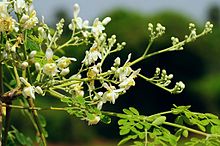| Moringa oleifera | |
|---|---|

| |
| Scientific classification | |
| Kingdom: | Plantae |
| Clade: | Tracheophytes |
| Clade: | Angiosperms |
| Clade: | Eudicots |
| Clade: | Rosids |
| Order: | Brassicales |
| Family: | Moringaceae |
| Genus: | Moringa |
| Species: | M. oleifera
|
| Binomial name | |
| Moringa oleifera | |
| Synonyms[1] | |
| |

Moringa oleifera is a fast-growing, drought-resistant tree of the family Moringaceae, native to the Indian subcontinent and used extensively in South and Southeast Asia.[2] Common names include moringa,[3] drumstick tree[3] (from the long, slender, triangular seed-pods), horseradish tree[3] (from the taste of the roots, which resembles horseradish), or malunggay (as known in maritime or archipelagic areas in Asia).[4]
It is widely cultivated for its young seed pods and leaves, used as vegetables and for traditional herbal medicine. It is also used for water purification.[5][6]
- ^ Olson, M. E. (2010). Flora of North America Committee (ed.). eFlora summary: Moringaceae: Drumstick Family. Flora of North America, North of Mexico. Vol. 7. pp. 167–169.
- ^ "Moringa oleifera (horseradish tree)". Climate Action Business Incubator. 17 December 2019. Retrieved 17 May 2020.
- ^ a b c "Moringa oleifera". Germplasm Resources Information Network. Agricultural Research Service, United States Department of Agriculture. Retrieved 11 December 2017.
- ^ Serafico, M.E.; Perlas, L.A.; Magsadia, C.R.; et al. (2017). "Efficacy ofMalunggay(Moringa oleifera) leaves in improving the iron and vitamins A and B status of Filipino schoolchildren". Acta Horticulturae (1158): 293–302. doi:10.17660/actahortic.2017.1158.33. ISSN 0567-7572.
- ^ Kalibbala, H. M.; Wahlberg, O.; Hawumba, T. J. (1 December 2009). "The impact of Moringa oleifera as a coagulant aid on the removal of trihalomethane (THM) precursors and iron from drinking water". Water Science and Technology: Water Supply. 9 (6): 707–714. doi:10.2166/ws.2009.671.
- ^ Kalibbala, Herbert Mpagi (2012). Removal of natural organic matter and control of trihalomethanes formation in water treatment. Stockholm: Architecture and the Built Environment, KTH Royal Institute of Technology. ISBN 9789175013237. OCLC 939795543.